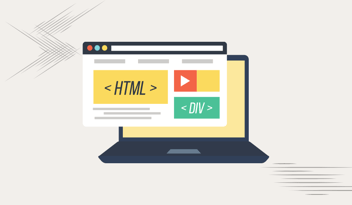
In my last blog post, I provided a checklist of important items to consider before designing a new website. Today, we will cover several questions to ask yourself during the design process and tips that can improve the appearance and functionality of the site.
1. Is it easy to navigate?
Now that you are in the process of laying out your sitemap and navigation items, it’s important to take a step back and consider the user experience. While it might be tempting to let aesthetics take precedence over functionality, users can quickly be deterred from a site if it is too difficult to navigate. Try limiting navigation items to a maximum of seven, and choose wording that is concise and specific. Keeping the navigation menu in a prominent place that is consistent on every page also helps the user explore the site more efficiently. Check out our article on designing an effective navigation menu for more information about this process.
2. Does it represent my unique brand?
Your website serves as the digital face of your company. Using intentional, cohesive brand elements on the site can communicate the spirit of your business and showcase what sets it apart from competitors. Designing a new site is a great opportunity to evaluate all current brand elements and make sure you have the following items in place to keep the process running smoothly:
- A cohesive color scheme for adding emphasis to important areas of the site and tying design elements and images together.
- Up-to-date, relevant images that accurately represent your style, services, and products
- One or two font pairings that are consistent with your logo, easy to read, and web compatible.
3. Does it look trustworthy?
An effective website should serve as a tool for building and retaining relationships. Design elements should not only be used to make the site beautiful but also to reinforce credibility and trustworthiness. Featuring a clean, simple layout and reducing clutter can help the site feel more professional and welcoming. You can also add authentic images or videos throughout the site to create a realistic expectation of your services or products and help the user get to know you better.
4. Will certain design elements slow down the site?
Designing with eye-catching images, videos, or graphics can improve the appearance of a site, but they can also slow it down if they are not built and formatted correctly. Not only does a slow-loading site hurt the user experience, but it can also affect your Google ranking. Remember to scale, compress, and size image and video files properly during the design process to save valuable loading time.
5. Is the design responsive?
A responsive design allows the content to appear and function cohesively across multiple screen sizes. Research shows 93% of users browse the internet on a mobile device, making it increasingly important to design your site with responsiveness in mind. Below are several ideas to help make your site design more compatible with mobile devices.
- Utilize a grid. Grids keep the content and design elements organized and consistent.
- Determine font sizes for desktop and mobile. This can eliminate unnecessary zooming or scrolling for the user.
- Design for the smallest screen first. This is especially important if you have data that indicates most of your visitors reach you via a mobile device rather than a desktop.
- Understand breakpoints. These are used to determine at what point the site content will need to shift rows or respond as the screen scales in size.
6. Can users follow the buyer’s journey to accomplish what they want?
Today’s consumers are well informed. Most do research online prior to choosing a product or service, requiring marketers to understand their needs and goals on a deeper level than ever before. Incorporating the buyer’s journey into your website design can help you make more informed decisions about the structure, layout, and design elements of the site, allowing you to personalize so it better resonates with your audience. It can also help you decide what areas of the site you want to emphasize more than others and what calls-to-action to include through out the design.
This list of questions should be a great start to designing your new website with the user in mind, resulting in a beautiful (and useful) site that generates new business.
If you have questions or need help with designing and developing your new website, contact Blue Frog. We’re a full-service marketing agency with offices in Denver, Des Moines, and Huron. Schedule a consultation today!



